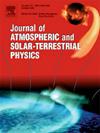2018年8月26日低纬度和极地地区强烈地磁风暴对电离层响应的研究
IF 1.9
4区 地球科学
Q3 GEOCHEMISTRY & GEOPHYSICS
Journal of Atmospheric and Solar-Terrestrial Physics
Pub Date : 2025-05-22
DOI:10.1016/j.jastp.2025.106528
引用次数: 0
摘要
2018年8月26日,在第24太阳活动周期的最小阶段,发生了强烈的地磁风暴。这场风暴意义重大,不仅因为它具有极高的磁场活动,而且还因为它对地球磁层的巨大影响。本文的目的是区分赤道/低纬度电离层对地磁风暴的响应与在极地电离层观测到的响应。在亚洲和南极地区的低纬度和极地地区使用了14个GPS接收器,研究了电离层对这次风暴的响应。对地磁风暴期间GPS-TEC数据的分析发现,低纬度和极纬地区的磁暴既有正面影响,也有负面影响。低纬度和极区所有台站的VTEC数据在磁暴开始前都有所增强,这是由于磁暴前太阳活动引起的cme和质子事件所致。从电场的迅速穿透、扰动发电机电场、中性风成分变化和风暴引起的风举效应等方面讨论了在不同经度扇区观测到的正、负地磁风暴效应。在8月27日至28日的恢复阶段,赤道/低纬度站在白天时段出现正风暴效应,而极地地区则出现负风暴效应。本文章由计算机程序翻译,如有差异,请以英文原文为准。
Study of ionospheric response to an intense geomagnetic storm of 26 August 2018 over low latitudes and polar regions
During, the minimum phase of Solar Cycle 24, an intense geomagnetic storm occurred on August 26, 2018. This storm is significant not only because of its extremely high magnetic activity but also due to its great impact on the geo-magnetosphere. The aim of this paper is to distinguish the response of the equatorial/low latitude ionosphere to geomagnetic storms from those observed in the polar ionosphere. The ionospheric response to this storm has been investigated using 14 GPS receivers at the low latitudes and polar regions in the Asian and Antarctic sectors. Analysis of GPS-TEC data during the geomagnetic storm found both positive and negative storm effects over low and polar latitudes. The enhancement in VTEC data before the commencement of the geomagnetic storm is observed over all the stations at low latitude and polar regions, which is attributed to the pre-storm solar-induced events like CMEs, and proton events. Observed geomagnetic storm effects at different longitude sectors, whether it is positive or negative, are discussed using prompt penetration of electric field, disturbance dynamo electric field, neutral wind composition changes, and storm-induced wind lifting effects. During the recovery phase on 27–28, August the positive storm effect is noticed in daytime hours at equatorial/low latitude stations, whereas the negative storm effect as in the polar region.
求助全文
通过发布文献求助,成功后即可免费获取论文全文。
去求助
来源期刊

Journal of Atmospheric and Solar-Terrestrial Physics
地学-地球化学与地球物理
CiteScore
4.10
自引率
5.30%
发文量
95
审稿时长
6 months
期刊介绍:
The Journal of Atmospheric and Solar-Terrestrial Physics (JASTP) is an international journal concerned with the inter-disciplinary science of the Earth''s atmospheric and space environment, especially the highly varied and highly variable physical phenomena that occur in this natural laboratory and the processes that couple them.
The journal covers the physical processes operating in the troposphere, stratosphere, mesosphere, thermosphere, ionosphere, magnetosphere, the Sun, interplanetary medium, and heliosphere. Phenomena occurring in other "spheres", solar influences on climate, and supporting laboratory measurements are also considered. The journal deals especially with the coupling between the different regions.
Solar flares, coronal mass ejections, and other energetic events on the Sun create interesting and important perturbations in the near-Earth space environment. The physics of such "space weather" is central to the Journal of Atmospheric and Solar-Terrestrial Physics and the journal welcomes papers that lead in the direction of a predictive understanding of the coupled system. Regarding the upper atmosphere, the subjects of aeronomy, geomagnetism and geoelectricity, auroral phenomena, radio wave propagation, and plasma instabilities, are examples within the broad field of solar-terrestrial physics which emphasise the energy exchange between the solar wind, the magnetospheric and ionospheric plasmas, and the neutral gas. In the lower atmosphere, topics covered range from mesoscale to global scale dynamics, to atmospheric electricity, lightning and its effects, and to anthropogenic changes.
 求助内容:
求助内容: 应助结果提醒方式:
应助结果提醒方式:


